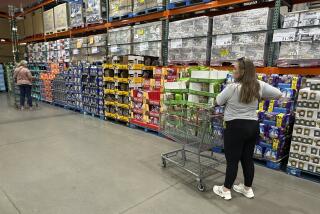Business Sales Decline 2.1% During Month
- Share via
WASHINGTON — Business sales plunged 2.1% in June, the second-biggest decline on record, as unsold inventories continued to pile up and give further evidence of a weak economy.
The Commerce Department said Wednesday that sales at the retail, wholesale and manufacturing levels dropped to $419.2 billion in June after posting a 0.4% increase in May. It was the second-largest monthly drop since the government began keeping records on total sales in 1967. The biggest decline was a 2.8% fall in March, 1975.
The drop in June sales caused an unwanted accumulation of inventories as well, pushing them up by 0.4% to a total of $580.1 billion.
With the sharp drop in sales and the rise in inventories, the length of time it would take to get rid of existing inventories at the June sales level rose to 1.38 months. The inventory-to-sales ratio had been 1.35 months in May.
Private analysts predicted that the economy will be plagued in coming months from this drag of slumping sales and unwanted inventory buildup.
“This is an unfavorable sign that points to continued sluggishness in the economy during the third quarter,” said Jerry Jasinowski, chief economist for the National Assn. of Manufacturers.
He predicted that the economy would grow at a weak annual rate of 2% in the third quarter, far below the 5% growth being forecast by the Administration.
The Reagan Administration’s forecast for a sharp rebound in growth during the second half of the year relies in part on a rebound in growth of inventories as businesses, confident of future sales, begin to restock their shelves.
The 0.4% overall increase in inventories followed a 0.4% May decline, which had been the biggest monthly inventory reduction in two years. The May drop had led to some optimism that businesses were getting their stockpiles under control and would begin placing new orders in coming months.
But the June inventory increase, the largest since February, dashed those hopes, leading forecasters to predict that further inventory liquidation will have to occur before industry will be receiving new orders.
“Retailers really did not make any headway in cutting back their inventories in the second quarter,” said economist David Wyss of Data Resources in Lexington, Mass. “This suggests that we are not going to get the kind of inventory bounce-back that a lot of people had hoped for in the second half of the year and strengthens our view that production is going to be weak.”
Edwin Warren, an economist at Chase Econometrics, another private forecasting firm, said consumer spending will be a key to whether the economy stays out of a recession.
While retail sales fell in both May and June, he noted that an advance report released Tuesday showed them increasing in July, although the gain was a modest 0.4%.
“If retail sales slip further, then we would really see some production declines in the fall,” Warren said. “But we believe consumer spending will continue to grow very slowly, and that will keep us from slipping into a recession.”
Robert Ortner, chief economist for the Commerce Department, said consumer spending should rise in the second half of the year because “incomes are still growing and consumers are indicating that they are still optimistic about the future.”
While all business segments were hit by slumping sales in June, wholesalers suffered the biggest setback, a 6.2% sales decline. Analysts said this decline reflected the weakness that has been affecting retail sales since April.
Reflecting the big decline in sales at the wholesale level, inventories held by wholesalers were also up a sharp 1.3%. Inventories held by manufacturers rose by 0.4%, while retail inventories fell by 0.4%.
More to Read
Inside the business of entertainment
The Wide Shot brings you news, analysis and insights on everything from streaming wars to production — and what it all means for the future.
You may occasionally receive promotional content from the Los Angeles Times.










